-
Paper Information
- Next Paper
- Previous Paper
- Paper Submission
-
Journal Information
- About This Journal
- Editorial Board
- Current Issue
- Archive
- Author Guidelines
- Contact Us
Resources and Environment
p-ISSN: 2163-2618 e-ISSN: 2163-2634
2012; 2(6): 265-270
doi: 10.5923/j.re.20120206.03
Food and Water Security in the Arab World and Sudan: Status and Threats
Nagat Ahmed Mustafa Elmulthum 1, Lubna Mohamed Musa 2, Hanan OsmanAli 2
1Department of Agricultural Economics, University of Gezira, Sudan
2Department of Soil Sciences, University of Gezira, Sudan
Correspondence to: Nagat Ahmed Mustafa Elmulthum , Department of Agricultural Economics, University of Gezira, Sudan.
| Email: |  |
Copyright © 2012 Scientific & Academic Publishing. All Rights Reserved.
Emphasizing the importance of food and water security, this study aimed at studying and analysing food and water security situation in the Arab World with special emphasis on Sudan. The Study employed descriptive statistics using secondary data collected from various sources. Results obtained indicated that food consumption gap in the Arab World increased by 24% in 2010 compared to 1973. Results obtained indicated that the per capita available water in the Arab World decreased from 3430 m3 in 1960 to 1250m3 in 2000 to 876 m3 in 2010. A further decline in per capita available water to 667m3 in 2025 and 500m3 in 2050 is expected. These figures reflects a threatening situation for water and food security in the Arab World during the current century bearing in mind that the water poverty line is estimated at 1000m3.The separation of Sudan into two countries has adversely affected the per capita available water in the democratic republic of Sudan. Results of the study proved that the self-sufficiency ratio of cereals in Sudan was less than 100% for most of the seasons during the period 1986/87-2006/07 indicating that production of cereal crops is below the consumption requirements of Sudanese people. The shift in consumption habits towards wheat in Sudan coupled with low comparative advantage resulted in low wheat self-sufficiency ratio during the period 1986/87-2007/08. This low self-sufficiency ratio in wheat gives an indication that the shortage in available food is mainly attributed to the significant consumption gap in wheat. Results indicated that wheat imports are real burden on Sudanese economy absorbing most of the foreign exchange generated from exports of Agricultural sector. Results obtained indicated that water productivity of Sorghum, Wheat and Groundnut grown in Gezira scheme in Sudan was very low compared to the average international water productivity. Based on the results of the study we recommend the allocation ofsubstantial financial resources to enhance food production, investment in water projects and efficient use of water with special consideration of health threats associated with the implementation of water projects. Development of along-termwater and food production plan for the Arab countries based on the principles of cooperation and equitable distribution is highly recommended.
Keywords: Climate Change, Health Risks, Water Poverty line
Cite this paper: Nagat Ahmed Mustafa Elmulthum , Lubna Mohamed Musa , Hanan OsmanAli , "Food and Water Security in the Arab World and Sudan: Status and Threats", Resources and Environment, Vol. 2 No. 6, 2012, pp. 265-270. doi: 10.5923/j.re.20120206.03.
Article Outline
1. Introduction
- Food security is defined by[1] as access by all people at all times to enough food for an active and healthy life. Water resources sustainability is one of the important factors for food availability. Aiming at raising the awareness of people for the importance of water as a valuable resource United Nations has declared 2nd of March as World Water day. According to[2] water security involves the sustainable use and protection of water systems, the protection against water related hazards (floods and droughts), the sustainable development of water resources and access to water services for humans and the environment.Water is considered as a scarce resource with limited and fixed quantity. Water constitutes 70% of earth area which is equal to around 1400 m km3 . Out of this quantity 97.5% is salt water from oceans and seas. The remaining 2.5% (35 m km3) is fresh water from which less than 1% is available for human use. This is because most of the fresh water is frozen in north and south poles or found as underground deep water unavailable for human use. Water Resources are facing many challenges, important among which are the following -World population which is increasing at more than 2% annually is competing for the same amount of water from the beginning of live on earth. This,implies a continuous decrease in the per capita water available for use. An example for this threatening situation as indicated in[3] is that the average annual per capita available water in the middle east is expected to drop from 1000 m3 in (2010) to 500 m3 in (2050) which is the least when it is compared to other regions in the world. - According to (4) Arab countries face a serious food security challenge and that poverty rates are much higher than official numbers suggest. It blames the situationon vulnerability to volatile food prices, natural disasters and water scarcityAccording to[5] climate change has resulted in some of atmospheric phenomena including increases in temperature , drought and flooding. These phenomena has resulted in water pollution, desertification and flooding with their negative impacts on food and water security. For one degree increase in temperature evaporation is expected to increase by 4%Most of water resources are shared by two or more countries. No international agreements are set for organizing the use of water of the shared sources. Water resources in the Arab region which are shared with other regions constitute 66% of all water available in the Arab world. This has (as reported in[6]) resulted in conflicts between some countries sharing water resources.The Arab region is generally considered among the regions experiencing a severe shortage of water resources. It is argued by[7] that at least about $40 billion of investments will be needed over the next ten years to meet the acute shortage of water, particularly in the supply of fresh water, which has become one of the main problems facing Arab development in general, and the tourism and agricultural sectors in particular. Thus, Arab States must spend 1% of their annual GDP to ensure adequate water resources, particularly in the major cities, because the Arab region is poor in water resources compared with the international average. The number of Arab countries below the water poverty line increased from 3 countries in the middle of last century including Bahrain, Jordan and Kuwait to 11 in 1990 including Algeria Palestine, Qatar, Saudi Arabia, Somalia, Tunisia, United Arab Emirates, and Yemen. Seven more countries are expected to be below the water poverty line by 2025, (as in[6]).The importance, of resolving the issues of increasing water scarcity and climate change in the Arab region through innovation, science, investments and integrated water management and technological solutions was underlined by[8]. It also reiterated the need to strengthen knowledge, exchange information and recognize the fundamental role of water and food security in ensuring a stable political and economic future for an Arab region that is currently going through dramatic social and political transition.According to[9] the enlargement of Roseires Dam in Sudan by raising the height of Dam wall by 10m will result in some benefits e.g. increasing energy output by 500 GWH per year, allow for the development of new irrigation schemes in the future that would boost the economy of the country, improved health facilities for resettlement communities and provide essential services. However, the enlargement of Roseires Dam is expected to introduce important ecological and social changes in the environment that will produce a number of health risks which requires mitigation measures.The need of food crops for water differs by the type and stage of growth of crops. In addition, water is considered as the source of live for aquatic animals. Moreover, water is very crucial for natural range lands which depend on rainfall, whilepasturesdepend on irrigation and permanent creeks flow(as in[5]). It is reported in[10] that agriculture in Sudan accounts for the lion's share in the economic and social activities, contributing more than 40% of GDP in 1960s through 1980s, which declined to 36% in 2008. Three key policy recommendations emerge from (4) include improvement of data and capacity as the basis for evidence-based decision making. In addition, fostering growth that enhances food security at national and household levels is highly recommended. Moreover, enhancing the efficiency and retooling the allocation of public spending is expected to have a positive impact on food security in the Arab World.According to[11] Sudan was food insecure during the period 1986/1987-2007/08. The forecasted levels of self-sufficiency ratio in cereals during the period 2008/09-2019-2020 suggested that this situation is expected to continue during the next decade with the gap in wheat significantly contributing to the problem. According to[12] a ten per cent drop in annual rainfall results in 5.0, 7.3, and 3.0 percent in the production of total cereals, sorghum and millet in Sudan, a result which confirms the negative impact of climate change on Food Security in Sudan. Results obtained by[13] gave signs of negative impacts of trade liberalization and domestic polices on food security situation in Sudan. In addition, high levels of poverty negatively affect the ability of people to access the recommended amounts of food. This paper, aimed at studying and analysing food and water security situation in the Arab World in general and in Sudan in particular.
2. Methodology
- The study was based onsecondary datacollected from various sources. Data collected includedvariablesrelated tofood andwater securityin the Arab World in general andSudanin particular.Researchers employed descriptive statistics for analysis. Data from[6] was employed to analyse results related to self-sufficiency ratio in food of some of food items common in people diets in the Arab World and for food consumption gaps in the Arab World during the period 1973-2010. Aiming at reflecting water availability in the Arab world the authors used data on per capita available water in the Arab Worldfrom[3]. Based on data from[14] the food security situation in Sudan during the period 1986/87-2006/07 was analysed.
3. Results and discussion
- Agriculture isthe highest userof the world'sfresh water. It is estimatedthat 70%of the totalwater resourcesderived from lakes,waterwaysand aquifers is consumed by their rigation sector. The average requirement ofdrinking waterper personper day is estimated at 3 litres. The average daily amount of water required for producing daily per capita food consumption requirement is estimated at 3500 litres. Agricultureuses1000litresof water to produceonekgof grain. This amount is higher in Africa and Asia because of mismanagement of water use. Water requirement for production of one kg of rice is estimated at 1000-3000 litres of water. One Kg of beef fed by grains requires 13000- 15000litres of water (as in[3]).Scarcity of water may cause up to 10% food shortage which will be reflected in higher food prices affecting 103 million people earning one dollarorless per day. Water security is highly crucial for sustainable food supply accessible by everybody. Results in figure (1) indicated that self-sufficiency ratio in food in the Arab World for the year 2010 depends on the type and elasticity of food items. It is low for cereals and high for vegetables and fruits. Results obtained indicated that food consumption gap in the Arab world increased from $1.1 billionsin1973 to $27 billions in 2010 (24%) (figure 2).This may be attributed to a number of factors including population growth, reduction of real income, and the impact of climate change which negatively affected per capita available water and agricultural production. Results obtained indicated that the per capita available water in the Arab World decreased from 3430 m3 in 1960 to 1250m3 in 2000 to 876 m3 in 2010. A further decline in per capita available water to 667m3 in 2025 and 500m3 in 2050 is expected (figure 3). These figures reflects a threatening situation for water and food security in the Arab World during the current century bearing in mind that the water poverty line is estimated at 1000m3. According to[15]the separation of Sudan into two countries has resulted in a decline in per capita available water for democratic republic of Sudan from 787.5m3 to 555.5m3.
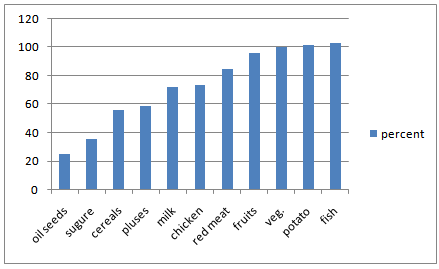 | Figure (1). Self-sufficiency in food in the Arab World (2010).Source: Authors’ presentation based on [6] |
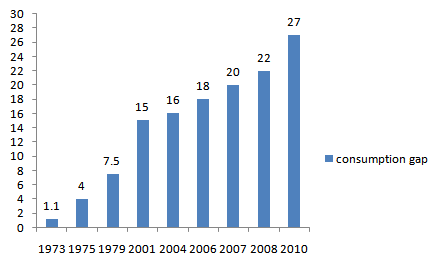 | Figure (2). Food consumption gap in the Arab World ( $ billions (1973-2010. Source: Authors’ presentation based on[6] |
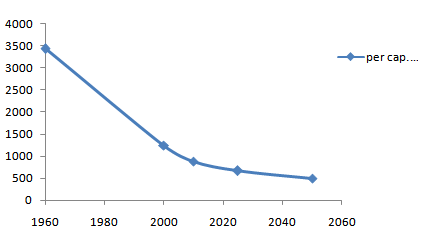 | Figure (3). Per capita available water in the Arab World in m3. Source: Authors’ presentation based on[3] |
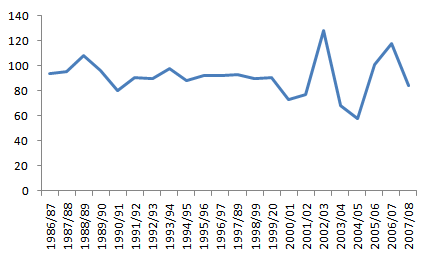 | Figure (4). Self-sufficiency Ratio in Cereals in Sudan (1986/87-2006/07). Source: Authors’ presentation based on[14] |
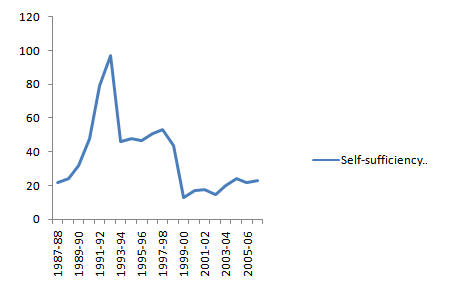 | Figure (5). Self-sufficiency Ratio in Wheat in Sudan(%).Source: Authors’ presentation based on[14] |
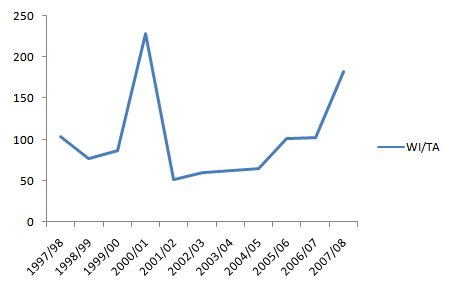 | Figure (6).Percentage of Wheat imports (WI)/ Total Agric. Exports (TA). Source: Authors’ presentation based on[14] |
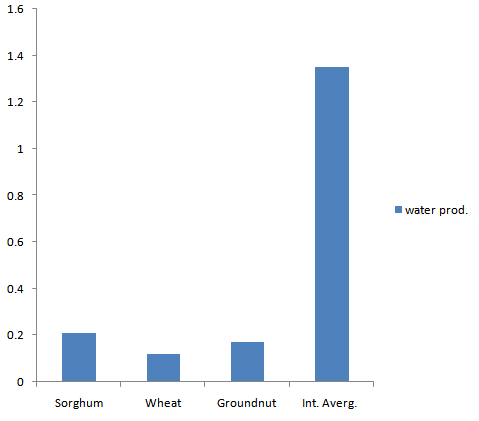 | Figure (7). Water productivity kg/m3 in Gezira Scheme, Sudan. Source: Authors’ presentation based on[16] |
4. Conclusions and Recommendations
- Analysis of the current situation of food and water security reflects a threatening situation in Sudan and the Arab World during the current century. Based on the results of the study we recommend the allocation ofsubstantial financial resourcesto enhancefood productionby investing inagricultural technology, education, health, nutrition, agricultural extension,and infrastructure. In addition, investment in water projects(damsand agricultural projects) in order toachieve food security is of highly importance with special consideration of health threats associated with the implementation of water projects. Moreover, emphasis should be placed on increasing the efficiency of water use through raising the awareness of citizens and decision makers of the efficient use of water. Furthermore, we recommend the development of along-termwater and food production plan between the Arab countriesbased on theprinciple of cooperation and the principle ofequitable sharing.
 Abstract
Abstract Reference
Reference Full-Text PDF
Full-Text PDF Full-Text HTML
Full-Text HTML